Electricity is the area in which you need to do everything correctly and thoroughly. In this regard, many prefer to understand everything on their own, and not to trust unauthorized people. One of the key points is to connect the wires in the junction box. The quality of the work depends on the first, the correctness of the system's work, and secondly - security is electrical and fire.

One of the types of distribution (dispense, splitting) box
What is a junction box
From the electric shield, the wires are diverged by rooms in the house or apartment. In each room, as a rule, not one connection point: a few sockets and the switch is accurate. To standardize the methods of connecting wires and collect them in one place, use junction boxes (they are sometimes called branching or dispensing). They are breeding cables from all connected devices, the compound of which occurs inside the hollow body.
So that in the process of the next repair does not search for wiring, it is paved according to certain rules that are written in PUE - rules of the device of electrical installations.
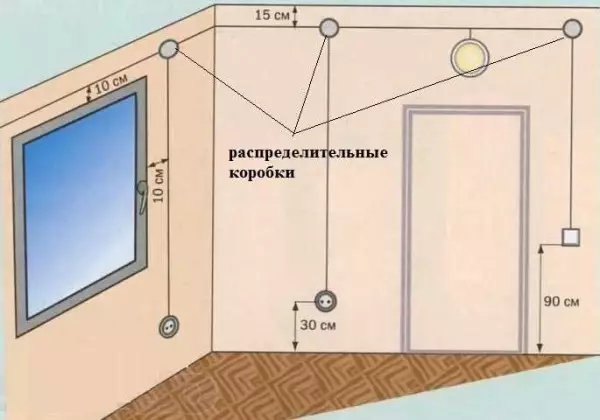
Terms of electrical wiring rules
One of the recommendations is to carry out all connections and branches of wires in the junction box. Therefore, the wires are allowed at the top of the wall, at a distance of 15 cm from the ceiling level. Having reached the place of branch, the cable is descended vertically down. In the place of branch, a junction box is installed. In it, there is a connection of all wires according to the desired scheme.
By type of installation, the camshafts are internal (for hidden editing) and external. Under the interior in the wall make a hole in which the box is embedded. With this installation, the cover is on the same level with the finishing material. Sometimes in the process of repairing it is closed with finishing materials. However, this installation is not always possible: the thickness of the wall or finishing does not allow. Then the box is used for outdoor installation, which is attached directly to the surface of the wall.
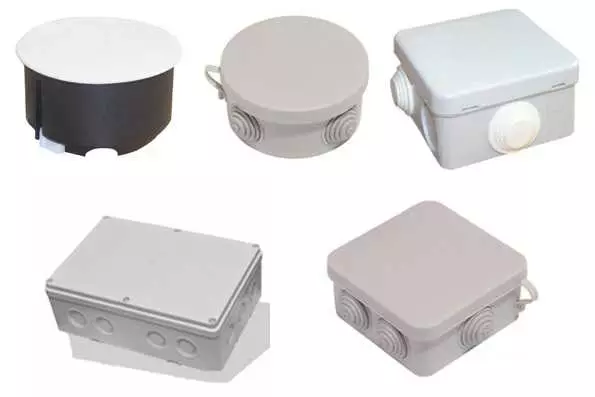
Some distribution boxes
In the form of the camshaft can be round or rectangular. Conclusions are usually four, but maybe more. The conclusions have a thread or fitting, which is convenient to mount the corrugated. After all, it is in the corrugated line or a plastic pipe to label the wires. In this case, replace the damaged cable will be very simple. First, disconnect it in the junction box, then from the consumer (socket or switch), pull and pull out. Tighten the new one in his place. If you put on the old manner - in the stroke, which is then lining with plaster - to replace the cable will have to hammer the wall. So this is the recommendation of PUE, to which it clearly worth listening to.
What makes junction boxes in general:
- Increased maintainability of the power supply system. Since all connections are available, it is easy to determine the area of damage. If the conductors are laid in cable channels (corrugations or pipes), there will be easy to replace the damaged area.
- Most of the electrical problems occur in the connections, and in this embodiment, they can be periodically inspected.
- Installation of junction boxes increases fire safety levels: all potentially dangerous places are in certain places.
- Requires smaller costs of money and labor than cable laying to each of the outlets.
Article on the topic: Switch "Bath-shower" - varieties and repair
Wire connection methods
In the box, the conductor can be connected in different ways. Some of them are more difficult, are implemented, others are easier, but with the right execution, they all ensure the required reliability.Twist
The most popular method of folk craftsmen, but the most unreliable. It is not recommended for Pue for use, since it does not provide proper contact, which can lead to overheating and the emergence of fire. This method can be used as temporary, for example, to verify the performance of the collected scheme, with a mandatory subsequent replacement to more reliable.
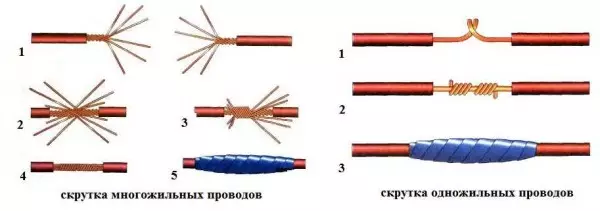
Proper twist of electrical wires
Even if the connection is temporary, you need to do everything according to the rules. Methods of twist of multicore and single-core conductors are similar, but have some differences.
When a twitch of stranded wires, the order of action is:
- Insulation is inspired by 4 cm;
- Conductors are spinning at 2 cm (pos. 1 in the photo);
- connected to the joint of the unwrapped conductors (pos 2);
- The veins are tightened with fingers (pos 3);
- The twist is tightened with pliers or passage (pos 4 in the photo);
- It is insulated (tape or reliable to connect a heat shrink tube).
Connection of wires in a distribution box with one residential with a twist is easier. Cleaning conductors are broken and twisted with their fingers over the entire length. Then take the tool (pliers and passage, for example). The conductors near the insulation are clamping, the conductors are second rapidly twisted, increasing the number of turns. Connection location is isolated.
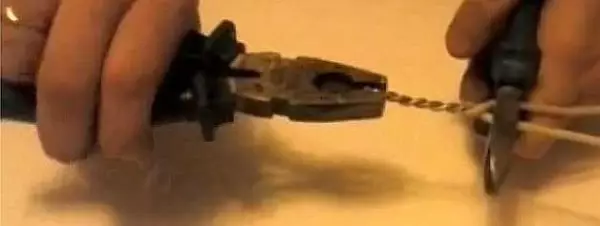
Twist with passwords or pliers
Twist with mounting caps
It is even easier to a twist with the use of special caps. With their use, the connection is more reliably inlaced, the contact is better. The outer part of such a cap is cast from a plastic that does not support the burning, inside the metal conical part with a thread is inserted. This insert provides a large surface of contact, improving the electrical characteristics of the connection. This is a great way to connect two (or more) wires without soldering.
The twist of the wires with the help of caps is even easier: the insulation is removed by 2 cm, the wires are slightly twisted. They wear a cap, with an effort turns several times, as long as the metal is inside the cap. All, the connection is ready.
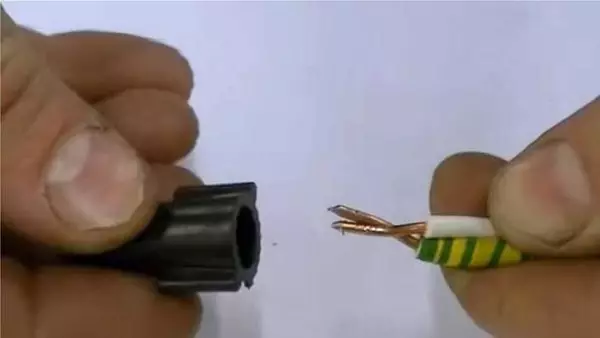
Wire connection using a cap
Caps are selected depending on the cross section and the number of conductors that must be connected. This method is more comfortable: the place takes less than the ordinary twist, everything stacked compact.
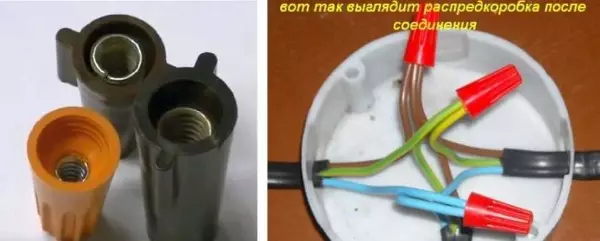
Connection of conductors in the distribution box caps
Soldering
If there is a soldering iron in the house, and you know how to contact him a little, it is better to use a soldering. Before the twig of the wires are broken: apply a layer of rosin or soldering flux. Preheated soldering iron dip in rosin, and spend several times stripped from the insulation of the part. It appears a characteristic flair of reddish.
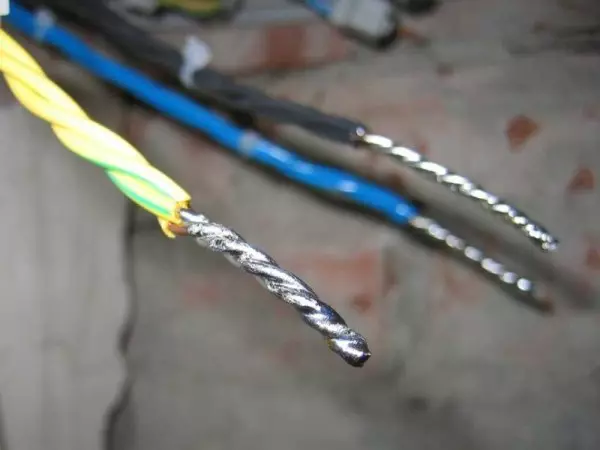
Speeded wires
After that, the wires are twisted, as described above (twist), then take a tin to the soldering iron, warm up the twist until the molten tin becomes the inclects between the turns, enveloping the connection and ensuring good contact.
This method of installers do not like: it takes a lot of time, but if you make the connection of the wires in the junction box, do not comply with the time and effort, you will save calmly.
Welding wires
If there is an inverter welding machine, you can use the welding connection. It makes over twist. Exhibit on the device welding current:- For a section of 1.5 mm2 about 30 A,
- For a section of 2.5 mm2 - 50 A.
Article on the topic: Wallpaper for the toilet in the apartment: 35 photos of the interior
The electrode use graphite (it is for copper welding). Grounding ticks neatly cling to the upper part of the twist, to it, they bring the electrode to it, which briefly touch, reaching the ignition of the arc, and remove. Welding occurs for a split second. After cooling, the connection place is insulated. Wire welding process in the junction box, see the video.
Terminal blocks
Another connection of the wires in the distribution box - with the help of terminal blocks - terminal shots, as they are also called. There are different types of pads: with clips and screw, but, in general, the principle of their device is one. There is a copper sleeve / plate and wiring system. They are arranged so that inserting two / three / four conductor into the right place, you connect them securely. In the installation, everything is very simple.
Screw terminal blocks have a plastic housing in which the contact plate is fixed. They have two types: with hidden contacts (new) and open - old sample. In any of them, the conductor purified from the insulation is inserted into the socket (length to 1 cm) and clamping with a screw and screwdriver.
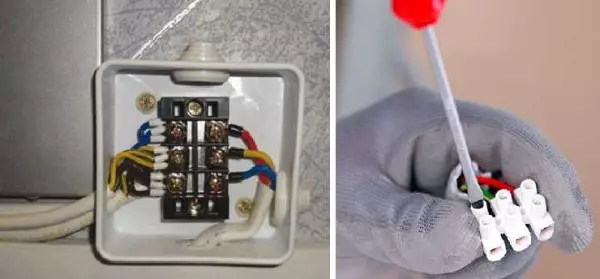
Connection of wires in the distribution box with terminal blocks
Their disadvantage is that it is not very convenient to connect a large number of wires in them. Contacts are located in pairs, and if you need to connect three and more wires, you have to be squeezed into one socket two wires, which is difficult. But they can be used in branches with significant current consumption.
Another type of pads is Vago Terminals. These are pads for quick installation. Mainly use two types:
- With a plane-free mechanism. It is also called disposable, since their use is repeated if it is possible, then with a significant deterioration in the quality of contact. Business in the inner structure: in the case there is a plate with spring petals. By inserting the conductor (only one-core), the petal is rejected by clamping the wire. Providing contact, it is crashed into a metal. If the conductor, with due effort and it will be possible to pull out, then the petal will not accept the same form. Because this type is considered one-time. Despite this connection is reliable, and you can use them. There are still special terminals of the same form, but in the black case. They contain an electrical paste inside. These connectors are needed if you have to connect copper and aluminum, which are simply not allowed due to active electrochemical processes that occur between them. Pasta prevents oxidation, allowing you to easily connect these two metal.
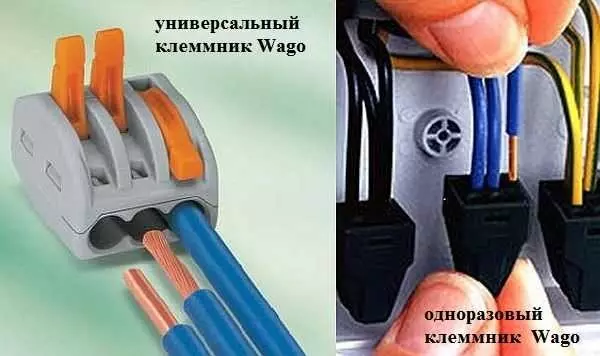
Vago terminal blocks
- Universal with lever mechanism. This is perhaps the most convenient connector. Insert a bare conductor (length is spelled out on the reverse side), click on a small lever. Connection is ready. If necessary, restore contact, lift the lever, remove the wire. Conveniently.
The peculiarity of these terminal blocks is that they can only be used at low currents: up to 24 A when the copper wire section is 1.5 mm, and up to 32 A with a cross section of 2.5 mm. When connecting loads with high current consumption, the wire connection in the junction box must be performed in another way.
Pressing
This method is possible in the presence of special ticks and a metal sleeve. The sleeve is put on the twist, it is inserted into the tick and clamping - it is pressed. This method is just suitable for lines with a large ampere load (like welding or soldering). Look in detail in the video. It even contains a distribution box model so it will be useful.Basic chosen schemes
To know which way to make the connection of wires in the distribution box is not all. It is necessary to figure out which conductors to connect.
How to connect sockets
As a rule, the rosette group goes a separate line. In this case, everything is clear: you have three cables for three (or two) conductor in the box. Coloring can be like in the photo. In this case, usually brown is a phase wire, blue - zero (neutral), and yellow-green - grounding.
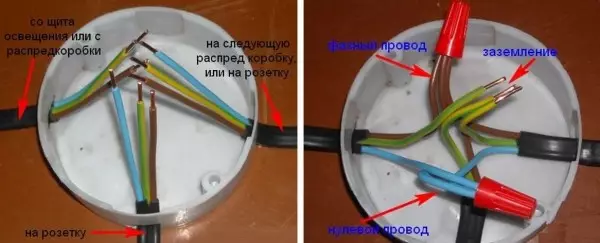
Scheme of the disconnection of the socket in the junction box
In another standard, color can be red, black and blue. In this case, the phase is red, blue - neutral, green - grounding. In any case, the wires are collected in colors: all one color in one group.
Then they fold, stretch, cut off to be the same length. Do not cut briefly, leave the reserve at least 10 cm so that if necessary, you can restore the connection. Then the conductors are connected by the selected method.
If there are only two wires are used (there are no shomping in the houses of the old building), everything is also just, only connections are two: phase and neutral. By the way, if the wires of the same color, pre-locate the phase (probe or multimeter) and mark it, at least, wound a piece of insulation tape.
Connecting a single-color switch
In the presence of switch, it's more difficult. There are also three groups, but they have another connection. there is
- input - from another junction box or from a shield;
- from chandelier;
- from switch.
How should the scheme work? Power - "Phase" - enters the switch key. From his exit served on the chandelier. In this case, the chandelier will burn only when the switch contacts are closed ("On" position). This type of connection is shown in the photo below.
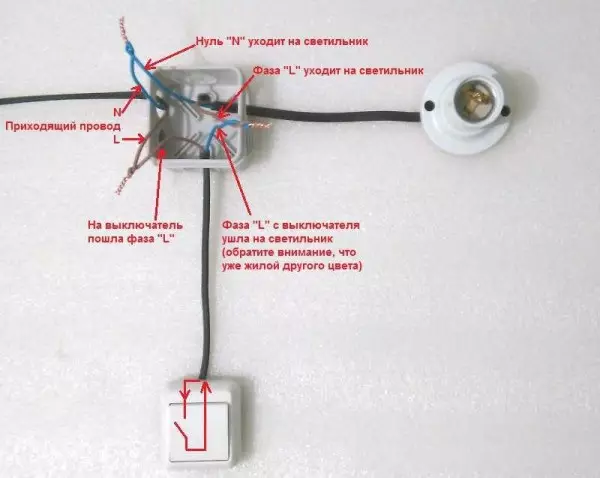
Connecting a single-block switch in the distribution unit
If you look carefully, it turns out: the phase is light wire enters the switch. It goes from another contact, but already blue (do not confuse) and connects with a phase wire that goes on the chandelier. Neutral (blue) and earth (if network) twisted directly.
Connecting a two-layer switch
Connecting wires in the junction box If there is a two-block switch, a little more complicated. The peculiarity of this scheme is that the switches into two groups of lamps, a three-core cable must be laid (in the circuit without grounding). One wire is connected to the general contact of the switch, two others - to the key outputs. At the same time it is necessary to remember what color the conductor is connected to the general contact.
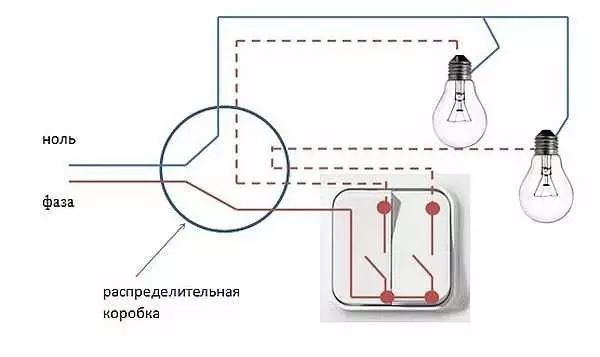
Connection diagram Two-block switches
In this case, the phase that came, connects to the common switch of the switch. Blue wires (neutral) from the entrance and two lamps simply twist all three together. Wires remain - phase from lamps and two wires from the switch. So we connect them pairwise: one wire from the switch to the phase of one lamp, the second output is to another lamp.
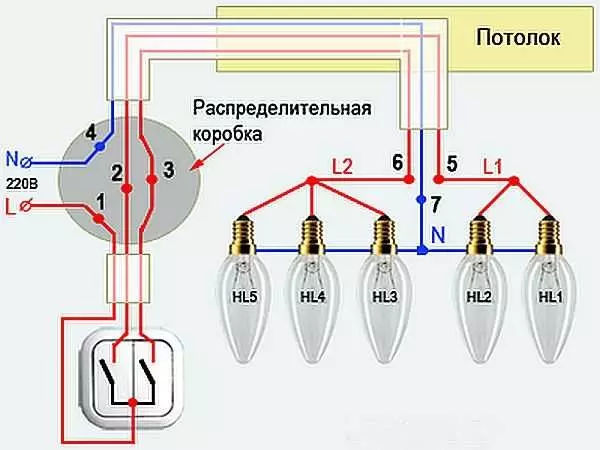
Wire Connection Scheme for Two-Waving Switch
Once again about the connection of the wires in the junction box with a two-block switch in the video format.
Article on the topic: Using liquid wallpapers for finishing a children's room
